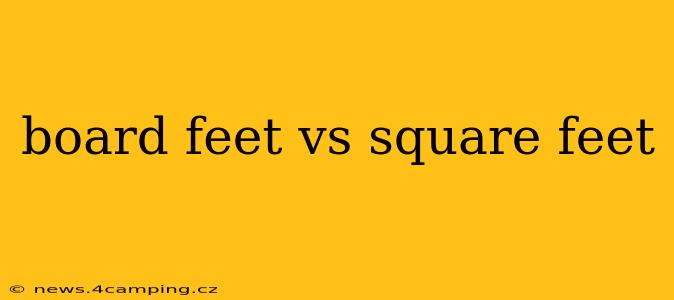For those working with lumber, the terms "board feet" and "square feet" are frequently encountered, often leading to confusion. While both measure dimensions of wood, they represent fundamentally different things. Understanding the distinction is crucial for accurate lumber ordering, cost calculations, and project planning. This article clarifies the difference between board feet and square feet, answering common questions along the way.
What is a Square Foot?
A square foot (sq ft) is a unit of area measurement. It's simply the area of a square with sides measuring one foot each. When you're measuring the surface area of a floor, a wall, or a piece of plywood, you're using square feet. The calculation is straightforward: length (in feet) x width (in feet) = square feet. Square footage is concerned only with the two-dimensional surface area.
What is a Board Foot?
A board foot (bd ft) is a unit of lumber volume. It represents a piece of lumber that is one foot long, one foot wide, and one inch thick. Unlike square feet, which only consider surface area, board feet factor in thickness. This is important because it reflects the amount of wood used, which directly impacts cost and strength.
Think of a board foot as a cube of wood, measuring 12 inches x 12 inches x 1 inch. However, lumber doesn't always come in these precise dimensions. To calculate board feet for irregularly sized lumber, use the following formula:
(Thickness in inches x Width in inches x Length in inches) / 144
Example: A 2-inch thick board, 6 inches wide, and 8 feet long (96 inches) would be calculated as: (2 x 6 x 96) / 144 = 8 board feet.
Why is the distinction important?
The difference between board feet and square feet is crucial for several reasons:
-
Accurate Lumber Ordering: Ordering lumber based on square footage alone can lead to significant errors, particularly when dealing with thicker boards. Using board feet ensures you order the correct volume of lumber needed for your project.
-
Cost Calculation: Lumber is typically priced per board foot. Using square feet for cost calculation would severely underestimate the cost, especially for thicker boards.
-
Structural Calculations: In construction and engineering, understanding the volume of wood (board feet) is critical for determining the structural strength and stability of a project.
How many square feet are in a board foot?
This question requires careful consideration. A board foot is a volume, whereas a square foot is an area. You can't directly convert one to the other without knowing the thickness of the wood. However, a one-inch thick board covering one square foot of area would be equal to one board foot. A two-inch thick board covering one square foot would be two board feet, and so on.
How do I convert square feet to board feet?
You can't directly convert square feet to board feet without knowing the thickness of the wood. To make the conversion, you must first determine the thickness of the lumber in inches. Then, multiply the square footage by the thickness in inches. This will give you the volume in cubic inches. Finally, divide this volume by 144 to obtain the board feet.
Example: If you have 100 square feet of 1-inch thick lumber, you have 100 board feet (100 sq ft * 1 inch / 144 sq in/bd ft ≈ 100 bd ft). If you have 100 square feet of 2-inch thick lumber, you have 200 board feet (100 sq ft * 2 inches / 144 sq in/bd ft ≈ 200 bd ft).
When would I use square feet versus board feet?
Use square feet when calculating surface area for things like painting, flooring, or determining the size of a sheet of plywood. Use board feet when ordering, pricing, or calculating the volume of lumber for construction projects.
Understanding the difference between board feet and square feet is essential for anyone working with lumber, ensuring accuracy in measurements, cost calculations, and project success.
